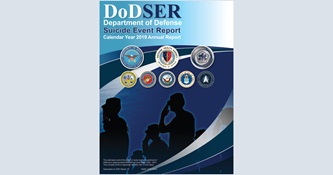Skip subpage navigation
By Jennifer Tucker, Ph.D.
July 12, 2021

The 2019 Department of Defense Suicide Event Report (DoDSER) Annual Report was published today and details the total numbers of reported suicide deaths and attempts among U.S. service members during calendar year 2019. The report also describes suicide mortality rates for the military components and services and presents changes in military suicide rates over time, comparisons of military and U.S. general population suicide rates, and relative frequencies of key risk factors.
2019 Military Suicide Mortality Rates
- For the active component, the rate was 25.9 suicide deaths per 100,000 service members. Service-specific rates were as follows:
- Air Force: 25.1 suicide deaths per 100,000 airmen
- Army: 29.8 suicide deaths per 100,000 soldiers
- Marine Corps: 25.3 suicide deaths per 100,000 Marines
- Navy: 21.5 suicide deaths per 100,000 sailors
- Space Force: 0 suicides per 100,000 population (from establishment of Space Force on Dec. 20, 2019 through Dec. 31, 2019)
- For the Reserves, the rate was 18.2 suicide deaths per 100,000 reservists.
- For the National Guard, the rate was 20.3 per 100,000 Guard members.
Comparisons of military suicide mortality rates with U.S. adult suicide mortality rates
After adjusting for age and sex differences between the military and U.S. general adult populations, all changes observed in suicide mortality rates for the military populations for calendar years 2011-2018 were consistent with the increase in the suicide mortality rate for the U.S. adult population over the same time frame. The comparison only extends through calendar year 2018 because 2019 U.S. population data were not available when the analyses were conducted.
Methods of injury reported via the DoDSER system
- Personal firearm use was the most common method of injury reported for suicide deaths among members of the active component (59.9 percent), the Reserves (67.9 percent), and the National Guard (72.7 percent).
- Drug and/or alcohol overdose was the most common method of injury reported to the DoDSER system for suicide attempts among members of the active component (53.1 percent), the Reserves (46.6%), and the National Guard (44.8%).
If you're writing about or interpreting findings from the 2019 DoDSER Annual Report and have questions or need clarification, contact the PHCoE DoDSER team. You can find DoDSER annual reports for previous calendar years on the DoDSER webpage. The clinical support tools section contains valuable suicide prevention resources, including evidence-based provider worksheets and factsheets for military leaders, service members, and family members.
Dr. Tucker is a research psychologist and suicide intervention subject matter expert at the Psychological Health Center of Excellence. She has master's and doctoral degrees in clinical psychology and has worked with service members hospitalized for suicide risk.
You are leaving Health.mil
The appearance of hyperlinks does not constitute endorsement by the Department of Defense of non-U.S. Government sites or the information, products, or services contained therein. Although the Defense Health Agency may or may not use these sites as additional distribution channels for Department of Defense information, it does not exercise editorial control over all of the information that you may find at these locations. Such links are provided consistent with the stated purpose of this website.
You are leaving Health.mil
View the external links disclaimer.
Last Updated: September 14, 2023